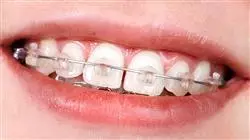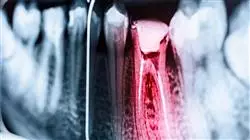University certificate
The world's largest faculty of dentistry”
Introduction to the Program
Dentists must keep up-to-date with advances in the field of Dentofacial Orthopedics to provide more precise treatments to their patients"

Dentofacial Orthopedics aims to correct the width, length, or height of the jaws; to stimulate or inhibit jaw growth when it is altered; or to improve dental eruption. But there are other abnormalities that can be prevented or cured thanks to this specialty, such as the reduction or elimination of dental crowding; the correction of habits such as thumb sucking or abnormal swallowing, or asymmetry problems, as well as preserving spaces for permanent teeth that have not yet erupted.
This Professional master’s degree in Dentofacial Orthopedics will allow the student to review the fundamental knowledge of craniofacial growth and to understand the best way to guide abnormal growth in order to correct dental and facial malpositions.
This training is distinguished by its order and distribution of theoretical material, guided practical examples in all its modules, and motivational and explanatory videos. This enables direct clinical management, guiding both the professional and the entire team towards the diagnosis, treatment, and monitoring of patients.
In this way, the student will learn about the most used and effective functional appliances, from expanders, disjunctors, and appliances, to the latest innovations in treatment with clear aligners.
In short, the objective is that the student, after completing this Professional master’s degree, will be able to completely diagnose patients' growth disorders and carry out effective treatment adapted to the patient's needs.
Broaden your knowledge by taking this Professional master’s degree in Dentofacial Orthopedics"
This Professional master’s degree in Dentofacial Orthopedics contains the most complete and updated scientific program on the market. The most important features of the program include:
- Developing practical cases presented by experts inDentofacial Orthopedics
- The graphic, schematic, and eminently practical contents with which they are created provide scientific and practical information on the disciplines that are essential for professional practice
- The latest developments in Dentofacial Orthopedics
- Practical exercises where the self-assessment process can be carried out to improve learning
- Special emphasis on innovative methodologies in Dentofacial Orthopedics
- Theoretical lessons, questions to the expert, debate forums on controversial topics, and individual reflection assignments
- Content that is accessible from any fixed or portable device with an Internet connection
This Professional master’s degree may be the best investment you can make when choosing a refresher program for two reasons: in addition to updating your knowledge in Dentofacial Orthopedics, you will obtain a Master's from TECH Global University"
The teaching staff includes a team of Orthodontic and Dentofacial Orthopedics specialists, who bring their experience to this training program, as well as renowned specialists from leading scientific societies.
The multimedia content developed with the latest educational technology will provide the professional with situated and contextual learning, i.e., a simulated environment that will provide immersive training program to train in real situations.
This program is designed around Problem Based Learning, whereby the orthodontist must try to solve the different professional practice situations that arise during the course. For this purpose, the dentist will be assisted by an innovative interactive video system created by renowned and experienced experts in the field of Dentofacial Orthopedics with extensive teaching experience.
Do not hesitate to take our training program and enhance your daily practice"

This 100% online Professional master’s degree will allow you to combine your studies with your professional work while increasing your knowledge in this field"
Why study at TECH?
TECH is the world’s largest online university. With an impressive catalog of more than 14,000 university programs available in 11 languages, it is positioned as a leader in employability, with a 99% job placement rate. In addition, it relies on an enormous faculty of more than 6,000 professors of the highest international renown.

Study at the world's largest online university and guarantee your professional success. The future starts at TECH”
The world’s best online university according to FORBES
The prestigious Forbes magazine, specialized in business and finance, has highlighted TECH as “the world's best online university” This is what they have recently stated in an article in their digital edition in which they echo the success story of this institution, “thanks to the academic offer it provides, the selection of its teaching staff, and an innovative learning method aimed at educating the professionals of the future”
A revolutionary study method, a cutting-edge faculty and a practical focus: the key to TECH's success.
The most complete study plans on the university scene
TECH offers the most complete study plans on the university scene, with syllabuses that cover fundamental concepts and, at the same time, the main scientific advances in their specific scientific areas. In addition, these programs are continuously being updated to guarantee students the academic vanguard and the most in-demand professional skills. In this way, the university's qualifications provide its graduates with a significant advantage to propel their careers to success.
TECH offers the most comprehensive and intensive study plans on the current university scene.
A world-class teaching staff
TECH's teaching staff is made up of more than 6,000 professors with the highest international recognition. Professors, researchers and top executives of multinational companies, including Isaiah Covington, performance coach of the Boston Celtics; Magda Romanska, principal investigator at Harvard MetaLAB; Ignacio Wistumba, chairman of the department of translational molecular pathology at MD Anderson Cancer Center; and D.W. Pine, creative director of TIME magazine, among others.
Internationally renowned experts, specialized in different branches of Health, Technology, Communication and Business, form part of the TECH faculty.
A unique learning method
TECH is the first university to use Relearning in all its programs. It is the best online learning methodology, accredited with international teaching quality certifications, provided by prestigious educational agencies. In addition, this disruptive educational model is complemented with the “Case Method”, thereby setting up a unique online teaching strategy. Innovative teaching resources are also implemented, including detailed videos, infographics and interactive summaries.
TECH combines Relearning and the Case Method in all its university programs to guarantee excellent theoretical and practical learning, studying whenever and wherever you want.
The world's largest online university
TECH is the world’s largest online university. We are the largest educational institution, with the best and widest online educational catalog, one hundred percent online and covering the vast majority of areas of knowledge. We offer a large selection of our own degrees and accredited online undergraduate and postgraduate degrees. In total, more than 14,000 university degrees, in eleven different languages, make us the largest educational largest in the world.
TECH has the world's most extensive catalog of academic and official programs, available in more than 11 languages.
Google Premier Partner
The American technology giant has awarded TECH the Google Google Premier Partner badge. This award, which is only available to 3% of the world's companies, highlights the efficient, flexible and tailored experience that this university provides to students. The recognition as a Google Premier Partner not only accredits the maximum rigor, performance and investment in TECH's digital infrastructures, but also places this university as one of the world's leading technology companies.
Google has positioned TECH in the top 3% of the world's most important technology companies by awarding it its Google Premier Partner badge.
The official online university of the NBA
TECH is the official online university of the NBA. Thanks to our agreement with the biggest league in basketball, we offer our students exclusive university programs, as well as a wide variety of educational resources focused on the business of the league and other areas of the sports industry. Each program is made up of a uniquely designed syllabus and features exceptional guest hosts: professionals with a distinguished sports background who will offer their expertise on the most relevant topics.
TECH has been selected by the NBA, the world's top basketball league, as its official online university.
The top-rated university by its students
Students have positioned TECH as the world's top-rated university on the main review websites, with a highest rating of 4.9 out of 5, obtained from more than 1,000 reviews. These results consolidate TECH as the benchmark university institution at an international level, reflecting the excellence and positive impact of its educational model.” reflecting the excellence and positive impact of its educational model.”
TECH is the world’s top-rated university by its students.
Leaders in employability
TECH has managed to become the leading university in employability. 99% of its students obtain jobs in the academic field they have studied, within one year of completing any of the university's programs. A similar number achieve immediate career enhancement. All this thanks to a study methodology that bases its effectiveness on the acquisition of practical skills, which are absolutely necessary for professional development.
99% of TECH graduates find a job within a year of completing their studies.
Professional Master's Degree in Dentofacial Orthopedics
The growing demand for dental treatments in patients of all ages has generated a huge need in dental clinics, which require professionals who have taken a course in Orthodontics such as this online Profesisonal Master's Degree in Dentofacial Orthopedics, which we present to you at TECH Global University. During the 12 months that this program lasts you will acquire rigorous and updated knowledge about orthodontics and dentofacial orthopedics, which will open up opportunities for a new job or a promotion, as well as extra points to be valued in the job market.
Professional Master's Degree in Dentofacial Orthopedics
By studying a postgraduate degree in orthodontics online at TECH you will be able to apply the newly acquired concepts in daily clinical practice, as it is designed following a revolutionary educational method that allows you to internalize and apply the knowledge in a natural and functional way through master classes, explanatory videos, and practical case analysis. You will update your knowledge in different areas of dentistry, focusing on orthodontics and orthopedics, and you will become more proficient and self-confident in applying the latest techniques and the most effective treatments to your patients.







